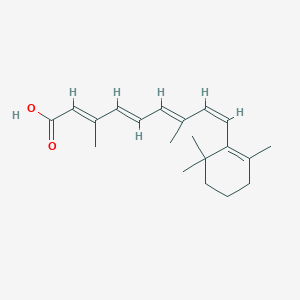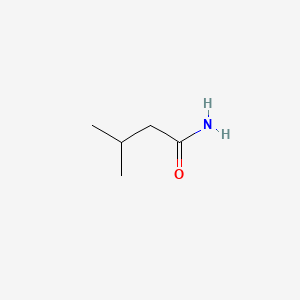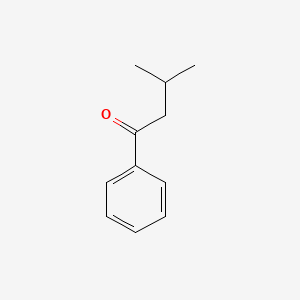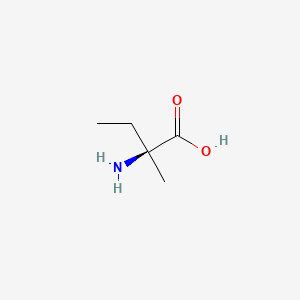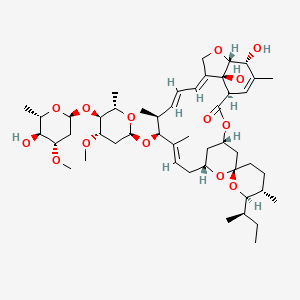
Ivermectina B1a
Descripción general
Descripción
Ivermectin B1a is a broad-spectrum antiparasitic agent belonging to the avermectin family of medications. It was discovered in 1975 and initially used in veterinary medicine to prevent and treat heartworm and acariasis. Approved for human use in 1987, ivermectin is used to treat infestations such as head lice, scabies, river blindness (onchocerciasis), strongyloidiasis, trichuriasis, ascariasis, and lymphatic filariasis .
Aplicaciones Científicas De Investigación
Aplicaciones Antiparasitarias
La ivermectina es reconocida por sus propiedades antiparasitarias. Es ampliamente utilizada para tratar infecciones parasitarias en humanos y animales, incluyendo oncocercosis, filariasis linfática y sarna . Su eficacia se deriva de su capacidad para paralizar y finalmente matar una variedad de parásitos.
Investigación Antiviral
Estudios recientes han explorado el potencial de la ivermectina como agente antiviral. Ha demostrado actividad contra virus de ARN como Zika, dengue y fiebre amarilla, así como virus de ADN como el Herpes equino tipo 1 . Su actividad antiviral de amplio espectro se está investigando más a fondo, especialmente en el contexto de la pandemia de COVID-19 .
Potencial Anticancerígeno
La ivermectina ha demostrado efectos antiproliferativos en diversas líneas celulares cancerosas. La investigación indica que puede mejorar la estabilidad de los microtúbulos, lo cual es una vía prometedora para el desarrollo de nuevos fármacos anticancerígenos . Su capacidad para inducir la apoptosis en las células cancerosas es un aspecto significativo de su perfil anticancerígeno.
Investigación Antidiabética
Si bien no se asocia tradicionalmente con el tratamiento de la diabetes, existe un creciente interés en la posible reutilización de la ivermectina para aplicaciones antidiabéticas. Sus efectos sobre el metabolismo de la glucosa y la sensibilidad a la insulina son áreas de investigación en curso .
Medicina Veterinaria
La ivermectina es un fármaco fundamental en la medicina veterinaria, utilizado para tratar una amplia gama de infecciones parasitarias en animales como ganado vacuno, caballos, ovejas y cerdos . Su actividad de amplio espectro la convierte en un elemento invaluable para mantener la salud y la productividad de los animales.
Aplicaciones en Acuicultura
En la acuicultura, la ivermectina se utiliza para controlar los parásitos en las poblaciones de peces. Su eficacia en este campo ayuda a mantener la salud de los peces de cultivo, lo cual es crucial para la sostenibilidad de las industrias acuícolas .
Estudios de Impacto Ambiental
El impacto ambiental de la ivermectina, particularmente su toxicidad para organismos no objetivo como invertebrados del suelo y plantas, es un área importante de estudio. Comprender su destino y efectos ambientales es fundamental para desarrollar directrices para su uso seguro .
Investigación Farmacocinética
Las propiedades farmacocinéticas de la ivermectina se están estudiando para optimizar su uso y eficacia. La investigación sobre su absorción, distribución, metabolismo y excreción ayuda a adaptar las dosis para diferentes aplicaciones y minimizar los efectos secundarios .
Mecanismo De Acción
Target of Action
Ivermectin B1a, also known as Ivermectin, primarily targets glutamate-gated chloride channels . These channels are common in nematodes, insects, and ticks . The role of these channels is to regulate the flow of chloride ions across the cell membrane, which is crucial for cell function and neurotransmission .
Mode of Action
Ivermectin B1a interacts with its targets by binding to these glutamate-gated chloride channels . This binding induces irreversible channel opening, leading to a very long-lasting hyperpolarization/depolarization of the neuron/muscle cell, thereby blocking further function . This interaction disrupts normal cell function, leading to paralysis and death of the parasite .
Biochemical Pathways
It is known that the drug interferes with the normal functioning of the targeted glutamate-gated chloride channels . This interference disrupts the normal flow of chloride ions, which is essential for the regulation of electrical activity in nerve and muscle cells . The disruption of these pathways leads to paralysis and death of the parasite .
Pharmacokinetics
Ivermectin B1a is characterized by low absorption when administered subcutaneously, a large volume of distribution, very small biotransformation, and slow excretion . It has been found that the half-life of Ivermectin B1a is around a day . The kinetics of ivermectin b1a are somewhat disconnected from its pharmacodynamics, as antiparasitic events persist for several months after a single dose of the drug .
Result of Action
The primary result of Ivermectin B1a’s action is the effective treatment of various parasitic diseases. It is a broad-spectrum anti-parasitic agent, primarily deployed to combat parasitic worms in veterinary and human medicine . It is also effective against other worm-related infections and diseases, plus several parasite-induced epidermal parasitic skin diseases, as well as insect infestations .
Action Environment
The action of Ivermectin B1a can be influenced by various environmental factors. For instance, when administered to livestock, between 80 and 98% of the drug is estimated to leave the body without being metabolized in feces, thus reaching the soil . This can lead to contamination in the soil and potential harm to non-target organisms . Therefore, the prudent use of Ivermectin B1a is recommended to reduce negative effects on the environment .
Análisis Bioquímico
Biochemical Properties
Ivermectin B1a exerts its antiparasitic activity by binding to glutamate-gated chloride channels expressed on nematode neurons and pharyngeal muscle cells . This binding induces irreversible channel opening and very long-lasting hyperpolarization/depolarization of the neuron/muscle cell, thereby blocking further function .
Cellular Effects
Ivermectin B1a has been shown to have a broad range of effects on various types of cells. It has been reported to inhibit the replication of severe acute respiratory syndrome coronavirus 2 (SARS-CoV-2) in cells . In addition to its antiviral effects, Ivermectin B1a also causes immunomodulation in the host . It has been shown to increase the activity of γ-aminobutyric acid receptor or glutamate-chloride ion channel (Glu-Cl), increase the influx of chloride ions, and cause the cell membrane hyperpolarization, thereby blocking signal transmission between neurons and muscles .
Molecular Mechanism
The molecular mechanism of action of Ivermectin B1a involves binding interactions with biomolecules, enzyme inhibition or activation, and changes in gene expression. Its primary target is glutamate-gated chloride channels, although it is also active against other invertebrate neurotransmitter receptors, including GABA-, histamine- and pH-sensitive channels . It produces antiparasitic activity by inducing irreversible channel opening and very long-lasting hyperpolarization/depolarization of the neuron/muscle cell .
Temporal Effects in Laboratory Settings
The effects of Ivermectin B1a over time in laboratory settings have been studied. For example, an in-vitro study reported that Ivermectin B1a inhibits SARS-CoV-2 replication with a 5000-fold reduction in viral RNA level during the first 48 h of usage . Another study found that single-dose Ivermectin B1a was ineffective in decreasing the time to a negative RT-PCR test .
Dosage Effects in Animal Models
The effects of Ivermectin B1a vary with different dosages in animal models. For example, a study of pharmacokinetics for Ivermectin B1a from Beagle dogs revealed that when the P-gp inhibitor curcumin was also co-administered orally, C max and AUC 0–∞ were found to be 177±57 and 4,213±948 h·μg·L −1, respectively .
Metabolic Pathways
Ivermectin B1a is metabolized, both in vivo and in vitro, by C-hydroxylation and O-demethylation reactions catalyzed by P450 3A4 as the major enzyme, with a contribution of P450 3A5 and 2C9 . In samples from both in vitro and in vivo metabolism, a number of metabolites were detected and as major identified metabolites were 3″-O-demethylated, C4-methyl hydroxylated, C25 isobutyl-/isopropyl-hydroxylated, and products of oxidation reactions .
Transport and Distribution
Ivermectin B1a is transported and distributed within cells and tissues. It is suggested that P-gp (MDR1) transporter participate in Ivermectin B1a efflux at low drug concentration with a slow transport rate. At the higher, micromolar concentration range, which saturates MDR1 (P-gp), MRP1, and to a lesser extent, MRP2 and MRP3 participate in Ivermectin B1a transport across physiological barriers .
Subcellular Localization
It is known that Ivermectin B1a can modulate the γ-aminobutyric acid type-A receptor (GABAAR), glycine receptor (GlyR) and neuronal α7-nicotinic receptor (nAChR), which are present in various subcellular locations .
Métodos De Preparación
Ivermectin B1a is synthesized from the fermentation products of the bacterium Streptomyces avermitilis. The preparation involves several steps:
Protection of Hydroxyl Groups: The 4’'-position hydroxyl and 5
Propiedades
| Ivermectin binds selectively and with high affinity to glutamate-gated chloride ion channels in invertebrate muscle and nerve cells of the microfilaria. This binding causes an increase in the permeability of the cell membrane to chloride ions and results in hyperpolarization of the cell, leading to paralysis and death of the parasite. Ivermectin also is believed to act as an agonist of the neurotransmitter gamma-aminobutyric acid (GABA), thereby disrupting GABA-mediated central nervous system (CNS) neurosynaptic transmission. Ivermectin may also impair normal intrauterine development of _O. volvulus_ microfilariae and may inhibit their release from the uteri of gravid female worms. | |
Número CAS |
70288-86-7 |
Fórmula molecular |
C48H74O14 |
Peso molecular |
875.1 g/mol |
Nombre IUPAC |
(1S,4S,5'S,6R,6'R,8R,10E,12S,13S,14E,16E,20R,21R,24S)-6'-[(2S)-butan-2-yl]-21,24-dihydroxy-12-[(2R,4S,5S,6S)-5-[(2S,4S,5S,6S)-5-hydroxy-4-methoxy-6-methyloxan-2-yl]oxy-4-methoxy-6-methyloxan-2-yl]oxy-5',11,13,22-tetramethylspiro[3,7,19-trioxatetracyclo[15.6.1.14,8.020,24]pentacosa-10,14,16,22-tetraene-6,2'-oxane]-2-one |
InChI |
InChI=1S/C48H74O14/c1-11-25(2)43-28(5)17-18-47(62-43)23-34-20-33(61-47)16-15-27(4)42(26(3)13-12-14-32-24-55-45-40(49)29(6)19-35(46(51)58-34)48(32,45)52)59-39-22-37(54-10)44(31(8)57-39)60-38-21-36(53-9)41(50)30(7)56-38/h12-15,19,25-26,28,30-31,33-45,49-50,52H,11,16-18,20-24H2,1-10H3/b13-12+,27-15+,32-14+/t25-,26-,28-,30-,31-,33+,34-,35+,36-,37-,38-,39-,40+,41-,42-,43+,44-,45+,47+,48+/m0/s1 |
Clave InChI |
AZSNMRSAGSSBNP-TYECJXEWSA-N |
SMILES |
CCC(C)C1C(CCC2(O1)CC3CC(O2)CC=C(C(C(C=CC=C4COC5C4(C(C=C(C5O)C)C(=O)O3)O)C)OC6CC(C(C(O6)C)OC7CC(C(C(O7)C)O)OC)OC)C)C |
SMILES isomérico |
CC[C@H](C)[C@@H]1[C@H](CC[C@@]2(O1)C[C@@H]3C[C@H](O2)C/C=C(/[C@H]([C@H](/C=C/C=C/4\CO[C@H]5[C@@]4([C@H](C=C([C@H]5O)C)C(=O)O3)O)C)O[C@H]6C[C@@H]([C@H]([C@@H](O6)C)O[C@H]7C[C@@H]([C@H]([C@@H](O7)C)O)OC)OC)\C)C |
SMILES canónico |
CCC(C)C1C(CCC2(O1)CC3CC(O2)CC=C(C(C(C=CC=C4COC5C4(C(C=C(C5O)C)C(=O)O3)O)C)OC6CC(C(C(O6)C)OC7CC(C(C(O7)C)O)OC)OC)C)C |
Apariencia |
Solid powder |
| 71827-03-7 70288-86-7 |
|
Pictogramas |
Acute Toxic; Health Hazard; Environmental Hazard |
Pureza |
>90% (or refer to the Certificate of Analysis) |
Vida útil |
>2 years if stored properly |
Solubilidad |
Insoluble |
Almacenamiento |
Dry, dark and at 0 - 4 C for short term (days to weeks) or -20 C for long term (months to years). |
Sinónimos |
MK-933; Ivermectin; Ivomec; L 64047; 1 Mectizan; MK 933; MK-0933; Noromectin; Pandex. |
Origen del producto |
United States |
Retrosynthesis Analysis
AI-Powered Synthesis Planning: Our tool employs the Template_relevance Pistachio, Template_relevance Bkms_metabolic, Template_relevance Pistachio_ringbreaker, Template_relevance Reaxys, Template_relevance Reaxys_biocatalysis model, leveraging a vast database of chemical reactions to predict feasible synthetic routes.
One-Step Synthesis Focus: Specifically designed for one-step synthesis, it provides concise and direct routes for your target compounds, streamlining the synthesis process.
Accurate Predictions: Utilizing the extensive PISTACHIO, BKMS_METABOLIC, PISTACHIO_RINGBREAKER, REAXYS, REAXYS_BIOCATALYSIS database, our tool offers high-accuracy predictions, reflecting the latest in chemical research and data.
Strategy Settings
| Precursor scoring | Relevance Heuristic |
|---|---|
| Min. plausibility | 0.01 |
| Model | Template_relevance |
| Template Set | Pistachio/Bkms_metabolic/Pistachio_ringbreaker/Reaxys/Reaxys_biocatalysis |
| Top-N result to add to graph | 6 |
Feasible Synthetic Routes
A: Ivermectin exerts its antiparasitic effect by acting as an agonist for glutamate-gated chloride channels. This leads to hyperpolarization of nerve and muscle cells in invertebrates, causing paralysis and death. []
A: Unlike conventional insecticides and repellents, Ivermectin targets glutamate-gated chloride channels, disrupting nervous system function in parasites. This unique mechanism sets it apart from other mosquito control agents. []
A: Ivermectin interacts with glutamate-gated chloride channels in mammals, but with significantly lower affinity compared to invertebrates, explaining its selective toxicity. []
A: Research suggests Ivermectin may interact with other targets, including P-glycoprotein (P-gp), a transmembrane protein involved in drug efflux. This interaction could influence Ivermectin's distribution and efficacy. [, ]
A: Ivermectin treatment disrupts neuromuscular transmission in parasites, leading to paralysis, reduced microfilarial production, and ultimately, death. [, ]
A: Ivermectin (C48H74O14) has a molecular weight of 875.09 g/mol. []
A: While the provided articles don't include specific spectroscopic data, various analytical techniques like GC/MS and HPLC have been used to detect and quantify Ivermectin in biological samples. []
A: Yes, computational drug repositioning using Connectivity Map (cMap) and data/pathway mining with the Ingenuity Knowledge Base has been employed to explore Ivermectin's potential in treating gastric cancer. []
A: Computational analyses identified nine molecular targets of Ivermectin in gastric cancer, suggesting its involvement in the Wnt/β-catenin signaling pathway and cell proliferation. In silico modeling showed Ivermectin's potential to inhibit this pathway. []
A: Ivermectin's lipophilic nature presents challenges for formulation, impacting its solubility and bioavailability. Strategies to overcome these limitations might include developing novel drug delivery systems. []
A: Yes, Ivermectin is available in various formulations, including oral tablets, topical creams, and injectables for veterinary use. [, , ]
A: Ivermectin is primarily metabolized by the liver and excreted in feces. Studies in cattle have shown that after topical application, a significant portion of the drug can be ingested through licking. [, ]
A: Yes, interspecies variations in Ivermectin's pharmacokinetics have been observed, likely due to differences in factors like P-glycoprotein activity. This highlights the need for species-specific dosing regimens. []
A: Yes, a case report described an adverse interaction between Ivermectin and Warfarin, a blood thinner, leading to worsened coagulopathy. This underscores the need to consider potential drug interactions when administering Ivermectin. []
A: Following a standard oral dose of Ivermectin, peak plasma concentrations are significantly lower than the concentration required for antiviral effects observed in in vitro studies. []
A: Studies indicate that a single dose of Ivermectin can significantly reduce the transmission potential of malaria for at least two weeks. []
A: While some studies suggest a potential benefit of Ivermectin in treating COVID-19, a large randomized controlled trial (ACTIV-6) found no significant improvement in recovery time among outpatients with mild to moderate COVID-19 treated with Ivermectin compared to placebo. [, ]
A: Yes, Ivermectin effectively treats various parasitic infections, including scabies, strongyloidiasis, trichuriasis, and onchocerciasis, in both humans and animals. [, , , , ]
A: Yes, several animal models, including jirds infected with H. contortus and cattle infected with O. ochengi, have been used to evaluate Ivermectin's efficacy and investigate resistance mechanisms. [, ]
A: Yes, Ivermectin resistance has been reported in several parasite species, including H. contortus, posing a significant threat to its long-term effectiveness. [, , ]
A: While the exact mechanisms are not fully understood, mutations in glutamate-gated chloride channels and alterations in drug efflux pumps like P-glycoprotein have been implicated in Ivermectin resistance. [, , ]
A: Yes, cross-resistance between Ivermectin and other macrocyclic lactones like moxidectin has been observed in some parasite populations. []
A: Although generally well-tolerated at recommended doses, Ivermectin can cause side effects, including dizziness, nausea, and allergic reactions. Severe adverse events are rare but can occur, especially in individuals with heavy Loa loa infections. [, , , ]
A: Ivermectin toxicity has been reported in animals, particularly in certain dog breeds with a genetic mutation affecting drug metabolism. Symptoms can range from neurological signs to liver damage. [, , ]
ANone: While specific drug delivery systems weren't discussed in the provided articles, researchers are continually exploring innovative approaches to enhance drug targeting and improve Ivermectin's bioavailability.
A: Gas chromatography-mass spectrometry (GC/MS) and high-performance liquid chromatography (HPLC) are commonly employed to detect and quantify Ivermectin levels in various matrices. []
A: Ivermectin, when used topically in cattle, can contaminate the environment through fecal excretion and licking behavior. This raises concerns about potential impacts on dung-degrading insects and soil ecosystems. []
A: Ivermectin's lipophilicity can limit its dissolution in aqueous environments, potentially impacting its absorption and bioavailability. []
A: Ivermectin's interaction with P-glycoprotein, a drug efflux transporter, highlights its potential to influence drug disposition and potentially contribute to resistance mechanisms. [, ]
A: The discovery of Ivermectin by Merck scientists in 1976, followed by its development into a highly effective antiparasitic drug for both human and veterinary use, marked significant milestones in its history. [, ]
A: Programs like the Onchocerciasis Control Programme (OCP) and the African Programme for Onchocerciasis Control (APOC), involving mass drug administration of Ivermectin, have significantly reduced the burden of these diseases. []
A: Yes, research on Ivermectin resistance mechanisms in parasites has implications for understanding drug resistance in other organisms, including cancer cells. [, ]
A: The study of Ivermectin has brought together researchers from diverse fields, including parasitology, pharmacology, immunology, and computational biology, to address challenges related to its efficacy, safety, and resistance. [, , ]
Descargo de responsabilidad e información sobre productos de investigación in vitro
Tenga en cuenta que todos los artículos e información de productos presentados en BenchChem están destinados únicamente con fines informativos. Los productos disponibles para la compra en BenchChem están diseñados específicamente para estudios in vitro, que se realizan fuera de organismos vivos. Los estudios in vitro, derivados del término latino "in vidrio", involucran experimentos realizados en entornos de laboratorio controlados utilizando células o tejidos. Es importante tener en cuenta que estos productos no se clasifican como medicamentos y no han recibido la aprobación de la FDA para la prevención, tratamiento o cura de ninguna condición médica, dolencia o enfermedad. Debemos enfatizar que cualquier forma de introducción corporal de estos productos en humanos o animales está estrictamente prohibida por ley. Es esencial adherirse a estas pautas para garantizar el cumplimiento de los estándares legales y éticos en la investigación y experimentación.


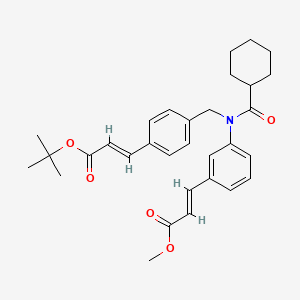

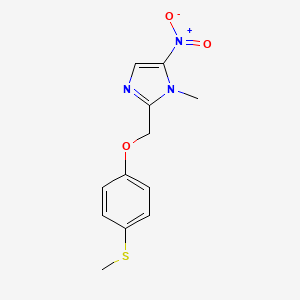
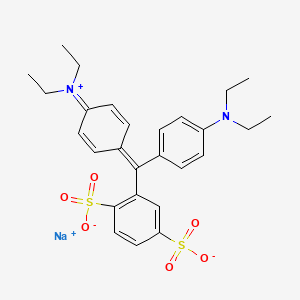
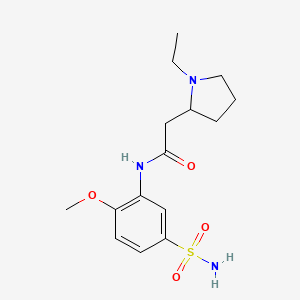



![17-Ethynyl-17-hydroxy-7,13-dimethyl-1,2,6,7,8,9,10,11,12,14,15,16-dodecahydrocyclopenta[a]phenanthren-3-one](/img/structure/B1672627.png)
